Research on BIPV in Office and Public Utility Buildings in Aesthetic and Utility Context
Abstract
1. Introduction
1.1. State-of–the Art
1.2. Novelty of the Research
- Research on the aesthetic and utility perception of BIPV among employees of the office and public utility buildings that use BIPV;
- Research conducted for BIPV as external glazing and shading systems to serve as façade solutions;
- Comparative studies related to various groups of buildings’ users (see Section 3).

1.3. Aim of the Study
- Are PV façades perceived as aesthetically acceptable?
- Are PV façades associated with ecology in a semantic context?
- Are there differences in the perception of PV façades when observed from the outside and from the inside?
- What influence of PV elements is most noticeable in the perception of interiors in aesthetic and utility context?
- Does the age of employees and the type of work (permanent, temporary) affect the perception of PV façade elements?
2. Materials and Methods
- The buildings in which the BIPV is used show a potential impact on both the exterior of the building and its internal environment;
- The buildings should represent one of two groups of objects, i.e., buildings with façade PV modules in the form of external shading elements (PV shelves) and as glazed façade partitions (PV glazing);
- The buildings should include working spaces where PV façade elements are visible. Facilities whose operation is related to PV technology (e.g., manufacturing plants) were rejected. This was done to eliminate the risk of the respondents’ biased opinions [49].
- Age (up to 40 years old and above): it was concluded that PV technology, being a modern technology, may have an impact on its perception depending on the respondents’ age.
- Related to the time spent in the room with BIPV, it was assumed that the difference in the working place occupancy could provide a factor that may influence the perception of BIPV in terms of shaping the internal environment.
- Collective responses: overall responses and responses divided into two groups, depending on the examined types of BIPV—general results (Section 3.1);
- Correlations of selected issues: answers to sets of questions with direct semantic connections with each other (Section 3.2);
- Answers divided according to employee characteristics—detailed results (Section 3.3).
3. Results and Discussion
3.1. Overall Results—Collective Answers
3.1.1. Group of Questions Concerning the Building’s Exterior (Questions 1–7)
| Collective Answers | Answers Conc. PV Shelves | Answers Conc. PV Glazing | |
|---|---|---|---|
| 1 | QUESTION 1 Do you consider the external wall covered with PV modules to be a representative building façade? | ||
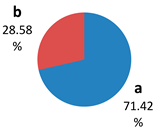 | 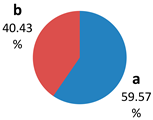 |  | |
| (a) Yes; (b) No | |||
| 2 | QUESTION 2 Do you think that PV elements within the façade have an impact on the overall appearance of the building? | ||
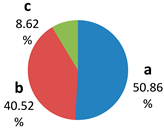 | 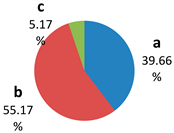 | 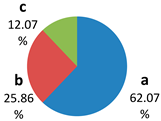 | |
| (a) Yes, the impact is significant; (b) Yes, but the impact is minor; (c) No | |||
| 3 | QUESTION 3 Do you think that PV elements affect the aesthetics of the façade when viewed from the outside? | ||
 | 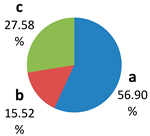 | 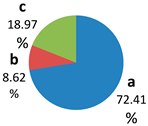 | |
| (a) Yes, they have a positive influence; (b) Yes, they have negative influence; (c) No | |||
| 4 | QUESTION 4 Do you consider the PV façade to have a modern image? | ||
 | 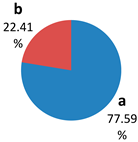 | 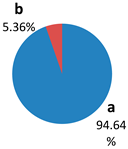 | |
| (a) Yes; (b) No | |||
| 5 | QUESTION 5 Do you consider the PV façade to be more interesting than the remaining façades of the building? | ||
 |  | 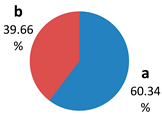 | |
| (a) Yes; (b) No | |||
| 6 | QUESTION 6 Does the PV façade evoke associations with an ecological building in your opinion? | ||
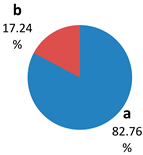 | 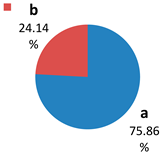 | 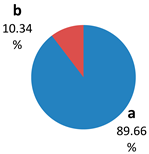 | |
| (a) Yes; (b) No | |||
| 7 | QUESTION 7 Do you think that using PV elements within the façade can positively impact the image of the company that occupies this building? | ||
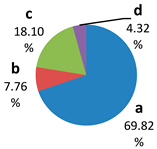 | 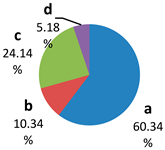 | 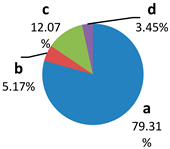 | |
| (a) Yes; (b) No; (c) It makes no difference to me; (d) I don’t know | |||
3.1.2. Group of Questions Concerning the Internal Environment (Questions 8–14)
| Collective Answers | Answers Conc. PV Shelves | Answers Conc. PV Glazing | ||
|---|---|---|---|---|
| 8 | QUESTION 8 When inside the building, do you feel the impact of PV elements on aesthetics of the internal space? | |||
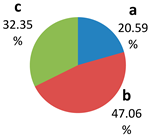 | 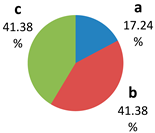 | 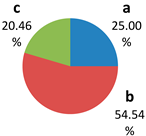 | ||
| (a) Yes, the impact is strong; (b) No, but the PV elements are perceptible; (c) No | ||||
| 9 | QUESTION 9 When inside the building, do you feel the impact of façade PV elements on natural lighting? | |||
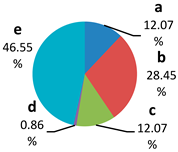 | 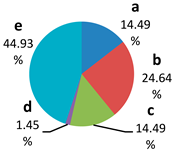 | 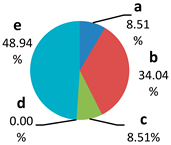 | ||
| (a) Yes, they cast shadow; (b) Yes, they limit daylight access; (c) Yes, they change daylight tint; (d) Yes—other; (e) No | ||||
| 10 | QUESTION 10 When inside the building, your feelings related to the influence of PV elements on daylighting are: | |||
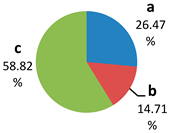 | 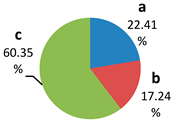 | 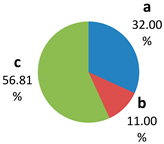 | ||
| (a) positive; (b) negative; (c) Indifferent (I don’t feel any influence) | ||||
| 11 | QUESTION 11 When inside the building, do you feel the impact of façade PV elements on the view to the outside? | |||
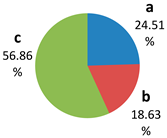 | 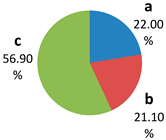 | 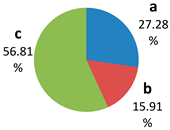 | ||
| (a) Yes, positive; (b) Yes, negative; (c) No | ||||
| 12 | QUESTION 12 Façade PV elements seen from the interior of the building, in your opinion… | |||
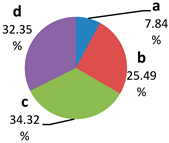 | 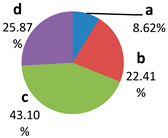 | 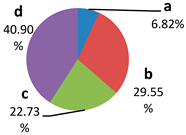 | ||
| (a) Look better than from the outside; (b) Look worse than from the outside; (c) Look the same; (d) I have no opinion | ||||
| Collective answers | ||||
| 13 14 | QUESTION 13 Do you think that PV shelves should be adjustable? | QUESTION 14 Would you like to have the possibility of individual adjustment of PV shelves? | ||
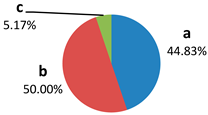 | 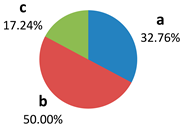 | |||
| (a) Yes; (b) It makes no difference to me; (c) No | ||||
3.2. Correlations of Selected Issues
3.2.1. The Influence of BIPV on External Aesthetics and Modernity
3.2.2. The Impact of BIPV on Associations with Ecology and the Company’s
3.2.3. The Impact of BIPV on Natural Lighting and Users’ Perception
3.2.4. The Influence of BIPV on the Aesthetics of the Interior and the View Outside
3.2.5. Mobility and the Regulation of PV Shelves
3.3. Detailed Results—Answers Broken down into Employee Characteristics
3.3.1. Perception of BIPV and Time Spent in the Room
3.3.2. Perception of BIPV and the Employees’ Age
3.4. Research Limitations
- The research included six buildings. The limited number of buildings has a positive effect on a joint research platform creation and, consequently, the reduction of the research variables; on the other hand, it does not cover all possible PV applications (e.g., mobile PV shelves—such solutions have not yet been introduced in Poland in the studied types of buildings);
- The research concerned only building workers. The employees represent varying degrees of interest and even understanding of the BIPV. A large part of the answers is “indifferent”, which does not allow to say whether it is a conscious answer or whether it results from a lack of interest in the subject of the research;
- The survey covered late spring and early summer periods. It was decided that the weather should be similar in each studied case to eliminate seasonal variation that could distort research results;
- Thus, the outcomes are limited to the relatively warm and sunny period. It would be a valuable supplement to conduct research for the autumn–winter period; however, this strategy would require the survey to be conducted on the same group of respondents, which was difficult to ensure in this case due to the anonymity of the surveys;
- The basic division into permanent and temporary employees who have access (physical or visual) to façade PV elements was adopted. Due to the length of the study, the spatial features of the workplace and the relationship with PV elements were not defined in detail. Such analyses should be the subject of further, more detailed research;
- The paper does not address the influence of gender on the perception of PV façades although the conducted survey covered this distinction. However, due to the uneven distribution, i.e., a definite predominance of men (approx. 85–15%), the presentation of the research results and a detailed interpretation thereof was abandoned. General observations, which cannot be seen as validated for the above reason, indicate that PV façades are more accepted by women when viewed from the outside and by men when viewed from the inside. However, men are also more indifferent in this case. A significant difference in favor of women was revealed in their interest in the possibility of handling PV shading elements and the connotation of PV façades with ecology. Other issues showed no significant differences. The gender-specific aspect of PV façade perception in aesthetic and utility terms requires separate, more objective research—it seems to provide an interesting and justified field of study.
4. Conclusions
- PV façades are generally aesthetically accepted; they are perceived as modern solutions, strongly related to the ecology and corporate image. Therefore, they constitute an appropriate aesthetic “tool” for creating such an image of the building’s architecture and its user (e.g., company); smooth glass PV façades are assessed more favorably—this result may be regarded as quite surprising in light of previous studies and proves the complexity of the issue described by Prieto and Oldenhave;
- The user’s perception is influenced by BIPV more when viewed from the outside. The internal environment evaluation is characterized by a greater degree of indifference as well as negative attitudes. The conclusion is that the development of photovoltaic technology directed towards BIPV must equally account for aspects related to the internal space shaping, including aesthetics of PV modules seen from the inside;
- The perception of the BIPV’s impact on the use of internal space is mainly related to the reduction of daylight access. Eye contact with the environment is much less important. Mobile PV shelf systems and their regulation possibilities are accepted, which generally responds to previous research insights concerning individual control over façade operation (e.g., by Tymkiewicz and Pastore and Andersen). For this reason, such solutions seem appropriate in applications wherever it is particularly important to create comfortable natural lighting conditions (e.g., office rooms) even at the expense of the view outside;
- The respondents’ characteristics have some importance in perceiving the BIPV’s impact. Users from the older group (> 40 years old) are more sensitive to the BIPV’s impact in terms of the utilitarian shaping of the internal environment, while the younger group (up to 40 years of age) pay more attention to the aesthetic aspects; they tend to express a more positive attitude towards them.
Funding
Institutional Review Board Statement
Informed Consent Statement
Data Availability Statement
Conflicts of Interest
References
- IEA. International Definitions of “BIPV” PVPS Task 15, Subtask C-International Framework for BIPV Specification; Report IEA-PVPS T15-4:2018; IEA International Energy Agency: Paris, France, 2018. [Google Scholar]
- Reijenga, T.H. PV in Architecture (No.22). In Handbook of Photovoltaic Science and Engineering; Lucue, A., Hegedus, S., Eds.; Willey: Chichester, UK, 2011. [Google Scholar]
- Strong, S. Building Integrated Photovoltaics (BIPV). Whole Building Design Guide; Solar Design Associates: Cambridge, MA, USA, 2005; Volume 11. [Google Scholar]
- Heinstein, P.; Ballif, C.; Perret-Aebi, L.-E. Building Integrated Photovoltaics (BIPV): Review, Potentials, Barriers, and Myths. Green 2013, 3, 125–156. [Google Scholar] [CrossRef]
- Tabakovic, M.; Fechner, H.; Knoebl, K. Development of Innovative Educational Material for Building-Integrated PV (Demi4BiPV). Framework and Requirements’ Analysis; The Dem4BIPV Consortium: Utrecht, The Netherlands, 2016. [Google Scholar]
- Ghosh, A. Potential of building integrated and attached/applied photovoltaic (BIPV/BAPV) for adaptive less energy-hungry building’s skin: A comprehensive Review. J. Clean. Prod. 2020, 276, 123343. [Google Scholar] [CrossRef]
- Attoye, D.E.; Tabet Aoul, K.A.; Hassan, A.A. Review on Building Integrated Photovoltaic Façade Customization Potentials. Sustainability 2017, 9, 2287. [Google Scholar] [CrossRef]
- Marchwiński, J.; Zielonko-Jung, K.; Szparkowski, Z. The influence of photovoltaic modules’ usage on the inner space environment and its architectural consequences. In Proceedings of the International Solar Conference Eurosun 2004, Freiburg, Germany, 20–23 June 2004. [Google Scholar]
- IEA. Compilation and Analysis of User Need for BIPV and its Functions. PVPS Task 15, Subtask C-International Framework for BIPV Specification; Report IEA PVPST15-06:2019; International Energy Agency: Paris, France, 2019. [Google Scholar]
- Marchwiński, J. Fasady Fotowoltaiczne Technologia PV w Architekturze [Photovoltaic Facades. PV Technology in Architecture]; WSEiZ: Warsaw, Poland, 2012. [Google Scholar]
- Gramy w Zielone—Portal Zielonej Energii. Available online: https://www.gramwzielone.pl/ (accessed on 3 July 2022).
- Hagemann, I. Architectural considerations for building-integrated photovoltaics. Prog. Photovolt. 1996, 4, 247–258. [Google Scholar] [CrossRef]
- Humm, O.; Toggweiler, P. Photovoltaics in Architecture; Birkhäuser Verlag: Berlin, Germany, 1993. [Google Scholar]
- Lisik, B. Struktury Fotowoltaiczne w Architekturze. [Photovoltaic Structures in Architecture]. Ph.D. Thesis, Wydział Architektury Politechniki Śląskiej, Gliwice, Poland, 1997. [Google Scholar]
- Dai, Y.; Bai, Y. Performance Improvement for Building Integrated Photovoltaics in Practise: A Review. Energies 2021, 14, 178. [Google Scholar] [CrossRef]
- Martín-Chivelet, N.; Gutiérrez, J.C.; Alonso-Abella, M.; Chenlo, F.; Cuenca, J. Building Retrofit with Photovoltaics: Construction and Performance of a BIPV Ventilated Façade. Energies 2018, 11, 1719. [Google Scholar] [CrossRef]
- Røyset, A.; Kolås, T.; Jelle, B.P. Coloured Building Integrated Photovoltaics: Influence on energy efficiency. Energy Build. 2020, 208, 109623. [Google Scholar] [CrossRef]
- Radwan, A.; Katsura, T.; Memon, S.; Serageldin, A.A.; Nakamura, M.; Nagano, K. Thermal and electrical performances of semi-transparent photovoltaic glazing integrated with translucent vacuum insulation panel and vacuum glazing. Energy Convers. Manag. 2020, 215, 112920. [Google Scholar] [CrossRef]
- Skandalos, N.; Tywoniak, J. Influence of PV facade configuration on the energy demand and visual comfort in office buildings. J. Phys. Conf. Ser. 2019, 1343, 2094. [Google Scholar] [CrossRef]
- Skandalos, N.; Karamanis, D. PV glazing technologies. Renew. Sustain. Energy Rev. 2015, 49, 306–322. [Google Scholar] [CrossRef]
- Tina, G.M.; Gagliano, G.; Nocera, F.; Patania, F. Photovoltaic Glazing: Analysis of Thermal Behavior and Indoor Comfort. Energy Proc. 2013, 42, 367–376. [Google Scholar] [CrossRef]
- Yu, G.; Yang, H.; Luo, D.; Cheng, X.; Ansah, M.K. A review on developments and researches of building integrated photovoltaic (BIPV) windows and shading blinds. Renew. Sustain. Energy Rev. 2021, 149, 111355. [Google Scholar] [CrossRef]
- Marchwiński, J. PV Technology in Building Elevations—Architectural Context. In Proceedings of the World Energy Renewable Energy Congress XI, Abu Dhabi, United Arab Emirates, 25–30 September 2010. [Google Scholar]
- Mesloub, A.; Ghosh, A.; Albaqawy, G.A.; Noaime, E.; Alsolami, B.M. Energy and Daylighting Evaluation of Integrated Semitransparent Windows with Internal Light Shelves in Open-Office Windows. Adv. Civ. Eng. 2020, 21, 558. [Google Scholar] [CrossRef]
- Singh, D.; Chaudhary, R. Performance evaluation of thermally insulated building integrated photovoltaic roof. Mater. Today Proc. 2021, 2021, 294. [Google Scholar] [CrossRef]
- Shukla, A.K.; Sudhakar, K.; Baredar, P. Recent advancement in BIPV product technologies: A review. Energy Build. 2017, 140, 188–195. [Google Scholar] [CrossRef]
- Zhu, I.; Shu, L.; Fan, Z. Recent Progress in Semi-transparent Perovskyte Solar Cell for Building-integrated Photovoltaics. Chem. Res. Chinese Univ. 2020, 2020, 53. [Google Scholar] [CrossRef]
- Szindler, M.; Szindler, M.; Drygała, A.; Lukaszkowicz, K.; Kaim, P.; Pietruszka, R. Dye Sensitized Solar Cell for Building-Integrated Photovoltaics (BIPV) Applications. Materials 2021, 14, 3743. [Google Scholar] [CrossRef] [PubMed]
- Marchwiński, J. Evaluation of PV Powered Switchable Glazing Technologies in terms of their Suitability for Office Windows in Moderate Climates. J. Green Build. 2021, 16, 81–110. [Google Scholar] [CrossRef]
- Mazzucchelli, E.S.; Alston, M.; Brzezicki, M.; Doniacovo, L. Study of a BIPV Adaptive System: Combining Timber and Photovoltaic Technology. J. Facade Design Eng. 2018, 6, 149–162. [Google Scholar] [CrossRef]
- Milosevič, V.; Marchwiński, J. Photovoltaic Technology Integration with Tensile Membrane Structures. A Critical Review. Teh. Vjesn. Teh. Gaz. 2022, 29, 702–713. [Google Scholar] [CrossRef]
- IEA. Coloured BIPV. Market, Research and Development. PVPS Task 15, Subtask E-International Framework for BIPV Specification; Report IEA PVPS T15-07; International Energy Agency: Paris, France, 2019. [Google Scholar]
- Li, Z.; Ma, T.; Yang, H.; Lu, L.; Wang, R. Transparent and Colored Photovoltaics for Building Integration. Solar RRL 2021, 5, 614. [Google Scholar] [CrossRef]
- Xiang, C.; Moscoso, C.; Szybinska Matusiak, B. Aesthetic Evaluation Criteria for Façade Integrated Photovoltaics in Urban Context. In Proceedings of the 38th European Photovoltaic Solar Energy Conference and Exhibition, Online, 6–10 September 2021; pp. 1540–1544. [Google Scholar]
- Sanchez-Pantoja, N.; Vidal, R.; Pastor, M. Aesthetic Impact of Solar Energy Systems. Renew. Sustain. Energy Rev. 2018, 98, 227–238. [Google Scholar] [CrossRef]
- Scognamilio, A. A Trans-Disciplinary Vocabulary for Assessing the Visual Performance of BIPV. Sustainability 2021, 13, 5500. [Google Scholar] [CrossRef]
- Niezabitowska, E.; Masły, D. Ocena Jakości Środowiska Zbudowanego i ich Znaczenie dla Rozwoju Koncepcji Budynku Zrównoważonego [Quality Assessments of the Built Environment and their Significance for the Development of the Sustainable Building Concept]; Wydawnictwo Politechniki Śląskiej: Gliwice, Poland, 2007. [Google Scholar]
- Tymkiewicz, J. Funkcje Ścian Zewnętrznych w Aspektach Badań Jakościowych. [Functions of the Exterior Walls in Quality Analyses Aspects]; Wydawnictwo Politechniki Śląskiej: Gliwice, Poland, 2012. [Google Scholar]
- Pastore, L.; Andersen, M. The influence of facade and space design on building occupants’ indoor experience. J. Build. Eng. 2022, 46, 103663. [Google Scholar] [CrossRef]
- Attia, S.; Navarro, A.L.; Juaristi, M.; Monge-Barrio, A.; Gosztonyi, S.; Al-Doughmi, Z. Post-Occupancy Evaluation for Adaptive Facades. J. Facade Des. Eng. 2018, 6, 3. [Google Scholar]
- Luna-Navarro, A.; Hunt, G.R.; Overend, M. Dynamic façades—An exploratory campaign to assess occupant multi-domain environmental satisfaction and façade interaction. Build. Environ. 2022, 211, 108703. [Google Scholar] [CrossRef]
- Kwon, M.; Remøy, H.; van den Bogaard, M. Influential design factors on occupant satisfaction with indoor environment in workplaces. Build. Environ. 2019, 157, 356–365. [Google Scholar] [CrossRef]
- Wilson, H.R. Chromogenic Glazing: Performance and Durability Issues as Addressed in IEA, Task 27, Freiburg. Available online: https://w.iea-shc.org/Data/Sites/1/publications/b2_Chromogenic_Glazing_Performance_21.pdf (accessed on 12 July 2022).
- IEA. Post-Occupancy Evaluation of Daylight in Buildings; A Report of IEA SHC TASK 21/ECBCS ANNEX 29; IEA: Paris, France, 1999. [Google Scholar]
- Montero-Parejo, M.J.; Moruno, L.G.; Rodríguez, A.M.R.; Hernández Blanco, J.; Velarde, J.G. Analysis of Façade Color and Cost to Improve Visual Integration of Buildings in the Rural Environment. Sustainability 2020, 12, 3840. [Google Scholar] [CrossRef]
- Prieto, A.; Oldenhave, M. What Makes a Façade Beautiful? Architects’ Perspectives on the Main Aspects That Inform Aesthetic Preferences in Façade Design. J. Facade Des. Eng. 2021, 9, 21–46. [Google Scholar] [CrossRef]
- Prieto, A.; Klein, T.; Knaack, U. Façade Integration: Survey-based Assessment of the Main Problems for the Integration of Building Services in Façade Systems. In Proceedings of the ID@50 Integrated Design Conference 2016, Bath, UK, 26 June–1 July 2016; pp. 435–446. [Google Scholar]
- Tablada, A.; Kosorić, V.; Huang, H.; Lau, S.S.Y.; Shabunko, V. Architectural quality of the productive facades integrated photovoltaic and vertical farming systems: Survey among experts in Singapore. Front. Archit. Res. 2020, 9, 301–318. [Google Scholar] [CrossRef]
- Kasirye, F. Errors in Survey Research and their Threat to Validity and Reliability; International Islamic University: Selangor, Malaysia, 2021. [Google Scholar] [CrossRef]
- Cohen, J.; Christiansen, T. Information and Choice; Oliver & Boyd: Edinburgh, UK, 1970. [Google Scholar]
- Szparkowski, Z. System Ekologiczny Architektury Zakładu Przemysłowego [Ecological System of the Industrial Plant Architecture]; WPW: Warszawa, Poland, 1977. [Google Scholar]
- Colarusso, C.A. Middle Adulthood (Ages 40–60). In Child and Adult Development. Critical Issues in Psychiatry; Springer: Boston, MA, USA, 1992. [Google Scholar] [CrossRef]
- Klimczuk, A. Adulthood. In The SAGE Encyclopedia of Theory in Psychology; Miller, H.L., Ed.; SAGE Publications: Thousand Oaks, CA, USA, 2016; pp. 15–18. [Google Scholar] [CrossRef]
- Słowińska, M. Use of the Chi-Square Tests in Consumer Preferences Studies. Eng. Sci. Technol. 2019, 1, 32. [Google Scholar] [CrossRef]
- Davies, C. High-tech Architecture; Thames and Hudson: London, UK, 1988. [Google Scholar]
- Złowodzki, M. Technologiczne i Środowiskowe Projektowanie Architektury Biur. [Technological and Environmental Design of the Office Architecture]; Wydawnictwo Politechniki Krakowskiej: Krakow, Poland, 1997. [Google Scholar]
- Marchwiński, J. Role and Factors of Solar Facades Shaping in Contemporary Architecture. Bud. Archit. 2021, 20, 43–56. [Google Scholar] [CrossRef]
- Minster of Infrastructure. Rozporządzenie Ministra Infrastruktury z 12.04.2002 r. w Sprawie Warunków Technicznych Jakim Powinny Odpowiadać Budynki i ich Usytuowanie [Ordinance of the Minister of Infrastructure of April 12, 2002 on Technical Conditions to be Met by Buildings and their Location]; Minster of Infrastructure: Warsaw, Poland, 2022. [Google Scholar]

| Building Covered with Survey Research | Implementation Year | PV Power | BIPV Type and Place of Its Application | |
|---|---|---|---|---|
| BIPV AS FAÇADE PV SHELVES | ||||
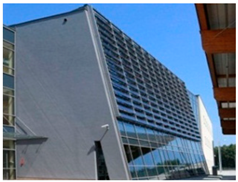 | 1. Office building of the PL-UA border crossing, Budomierz | 2013 | ~20 kWp | PV modules as PV shelves on a glass curtain wall oriented towards the south. |
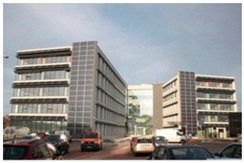 | 2. Office building– technological park Eurocentrum, Katowice | 2013/14 | 108 kWp | PV modules as large-sized PV shelves in the upper line of windows within the southern façade. |
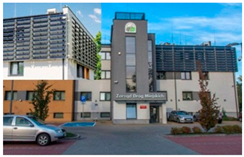 | 3. Administrative and office building of the Municipal Roads Authority (ZDM), Gliwice | 2012 | ~15 kWp | PV modules as PV shelves installed on the entire surface of the windows in the southern and eastern façades. |
| BIPV AS FAÇADE PV GLAZING | ||||
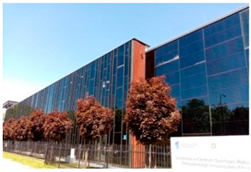 | 4. Public utility building WUM, Warsaw | 2016 | 60 kWp | Semi-transparent glass–glass PV modules with thin-film cells (PV glazing) in a curtain south-oriented façade. |
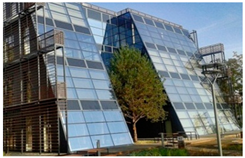 | 5. Administrative and office building WFOŚiGW, Łódź | 2015/16 | 45 kWp | Semi-transparent glass–glass PV modules with distanced thick-film cells (PV glazing) within the glass roof and south-oriented glass curtain wall. |
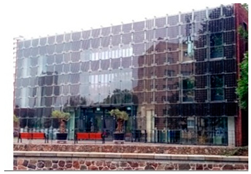 | 6. Administrative and office building WFOŚiGW, Gdańsk | 2015/16 | 40 kWp | Semi-transparent glass–glass PV modules with distanced thick-film PV cells (PV glazing) within the glass roof and south-oriented double glass curtain wall. |
| Perception Conc. Exterior | Perception Conc. Interior |
|---|---|
| 1. Do you consider the external wall covered with PV modules to be a representative building façade? | 8. When inside the building, do you feel the impact of façade PV elements on aesthetics of the internal space? |
| (a) Yes (b) No | (a) Yes, the impact is strong (b) No, but the PV elements are perceptible (c) No |
| 2. Do you think that PV elements within the façade have an impact on the overall appearance of the building? | 9. When inside the building, do you feel the impact of façade PV elements on natural lighting? |
| (a) Yes, the impact is significant (b) Yes, but the impact is minor (c) No | (a) Yes, they cast shadow (b) Yes, they limit daylight access (c) Yes, they change daylight tint (d) Yes—other (define the impact) (e) No |
| 3. Do you think that PV elements affect the aesthetics of the façade when viewed from the outside? | 10. When inside the building, yourfeelings related to the influence of PV elements on daylighting are: |
| (a) Yes, they have a positive influence (b) Yes, they have negative influence (c) No | (a) Positive (b) Negative (c) Indifferent—I don’t feel any influence |
| 4. Do you consider the PV façade to have a modern image? | 11. When inside the building, do you feel the impact of façade PV elements on the view to the outside? |
| (a) Yes (b) No | (a) Yes—positive (b) Yes—negative (c) No |
| 5. Do you consider the PV façade to be more interesting than the remaining façades of the building? | 12. Façade PV elements seen from the interior of the building, in your opinion… |
| (a) Yes (b) No | (a) Look better than from the outside (b) Look worse than from the outside (c) Look the same (d) I have no opinion |
| 6. Does the PV façade evoke associations withan ecological building in your opinion? | 13. Do you think that PV shelves should be adjustable? |
| (a) Yes (b) No | (a) Yes (b) It makes no difference to me (c) No |
| 7. Do you think that using PV elements within the façade can positively impact the image of the company that occupies this building? | 14. Would you like to have the possibility of individual adjustment of PV shelves? |
| (a) Yes (b) No (c) It makes no difference to me (d) I don’t know | (a) Yes (b) It makes no difference to me (c) No |
| Percentage Summary | Answers to the Correlation of Questions 3 and 4 | ||
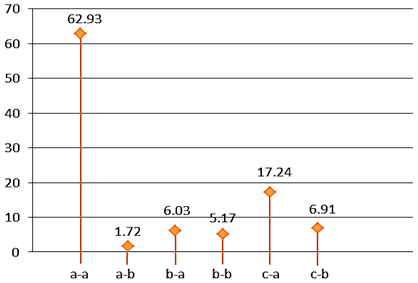 | 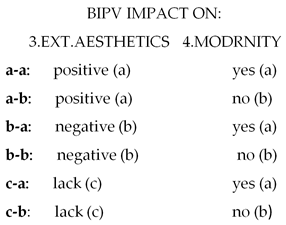 | ||
| Theoretical distribution | Empirical distribution | Correlation | |
| a-a | 16.66% | 62.93% | Positive (+46.27%) |
| a-b | 1.72% | Negative (−14.94%) | |
| b-a | 6.03% | Negative (−10.63%) | |
| b-b | 5.17% | Negative (−11.49%) | |
| c-a | 17.24% | Positive (+0.58%) | |
| c-b | 6.91% | Negative (−14.94%) | |
| Percentage Summary | Answers to the Correlation of Questions 6 and 7 | ||
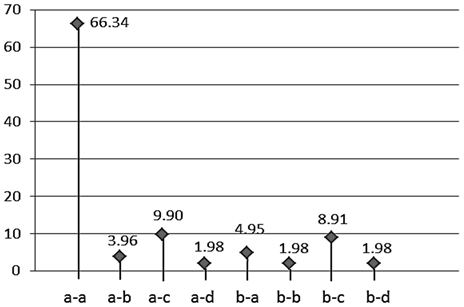 | 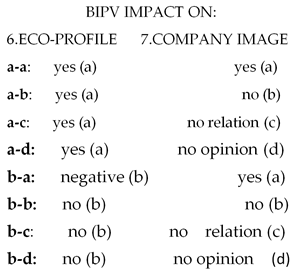 | ||
| Theoretical distribution | Empirical distribution | Correlation | |
| a-a | 12.50% | 66.34% | Positive (+53.84%) |
| a-b | 3.96% | Negative (−8.54%) | |
| a-c | 9.90% | Negative (−2.60%) | |
| a-d | 1.98% | Negative (−10.52%) | |
| b-a | 4.95% | Negative (−7.55%) | |
| b-b | 1.98% | Negative (−14,94%) | |
| b-c | 8.91% | Negative (−3.55%) | |
| b-d | 1.98% | Negative (−10.52%) | |
| Percentage Summary | Answers to the Correlation of Questions 9 and 10 | ||
 | 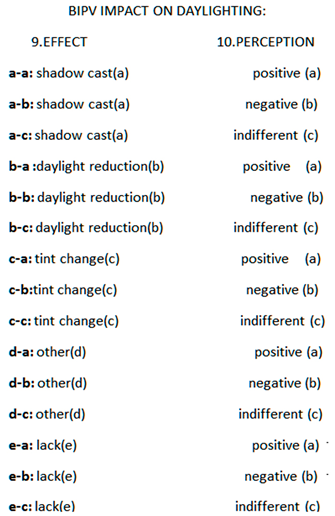 | ||
| Theoretical distribution | Empiricaldistribution | Correlation | |
| a-a | 6.66% | 9.17% | Positive (+2.51%) |
| a-b | 0.91% | Negative (−5.75%) | |
| a-c | 4.59% | Negative (−2.07%) | |
| b-a | 6.42% | Negative (−0.24%) | |
| b-b | 11.93% | Positive (+5.27%) | |
| b-c | 11.93% | Positive (+5.27%) | |
| c-a | 2.75% | Negative (−3.91%) | |
| c-b | 0% | Non-existent (−6.66%) | |
| c-c | 3.37% | Negative (−3.29%) | |
| d-a | 1.82% | Negative (−4.84%) | |
| d-b | 0% | Non-existent (−6.66%) | |
| d-c | 0% | Non-existent (−6.66%) | |
| e-a | 9.17% | Positive (+2.51%) | |
| e-b | 0.91% | Negative (−5.75%) | |
| e-c | 37.03% | Positive (+30.37%) | |
| Percentage Summary | Answers to the Correlation of Questions 8 and 11 | ||
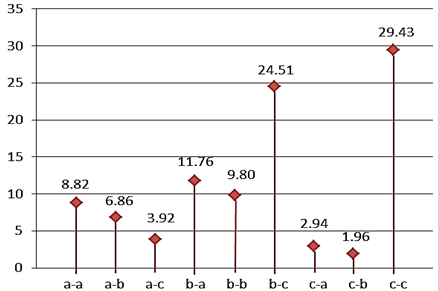 | 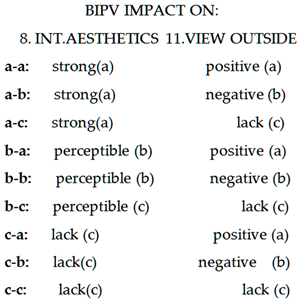 | ||
| Theoretical distribution | Empirical distribution | Correlation | |
| a-a | 11.11% | 8.82% | Negative (−2.29%) |
| a-b | 6.86% | Negative (−4.25%) | |
| a-c | 3.92% | Negative (−7.19%) | |
| b-a | 11.76% | Positive (+0.65%) | |
| b-b | 9.80% | Negative (−1.31%) | |
| b-c | 24.51% | Positive (+13.40%) | |
| c-a | 2.94% | Negative (−8.17%) | |
| c-b | 1.96% | Negative (−9.15%) | |
| c-c | 29.43% | Positive (+18.32%) | |
| Percentage Summary | Answers to the Correlation of Questions 13 and 14 | ||
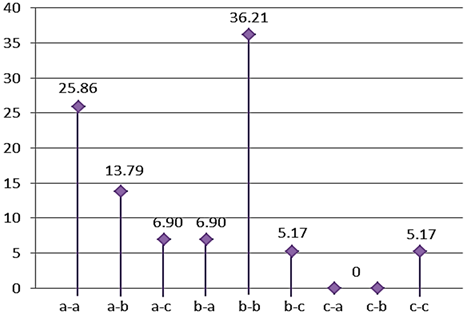 | 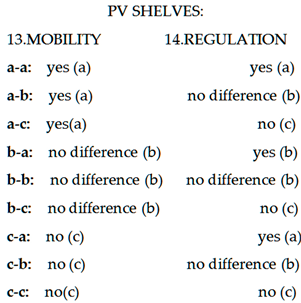 | ||
| Theoretical distribution | Empirical distribution | Correlation | |
| a-a | 11.11% | 25.86% | Positive (+14.75%) |
| a-b | 13.79% | Positive (+2.68%) | |
| a-c | 6.90% | Negative (−4.21%) | |
| b-a | 6.90% | Negative (−4.21%) | |
| b-b | 36.21% | Positive (+25.10%) | |
| b-c | 5.17% | Negative (−5.94%) | |
| c-a | 0% | Non-existent (−11.11%) | |
| c-b | 0% | Non-existent (−11.11%) | |
| c-c | 5.17% | Negative (−5.94%) | |
| QUESTION 8 When inside the building, do you feel the impact of façade PV elements on aesthetics of the internal space? | QUESTION 9 When inside the building, do you feel the impact of façade PV elements on natural lighting? |
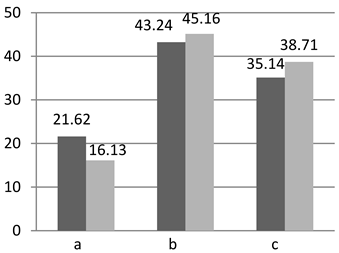 | 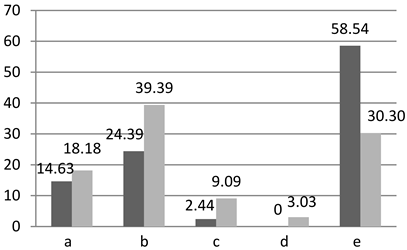 |
| (a) Yes, strong; (b) No, but PV is perceptible; (c) No | (a) Yes, cast shadow; (b) Yes, limit daylight; (c) Yes, change daylight tint; (d) Other; (e) No |
| QUESTION 10 When inside the building, your feelings related to the influence of PV elements on daylighting are: | QUESTION 11 When inside the building, do you feel the impact of façade PV elements on the view to the outside? |
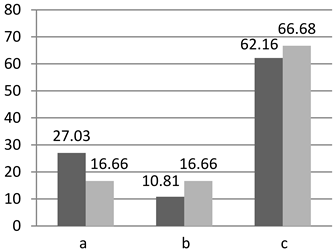 | 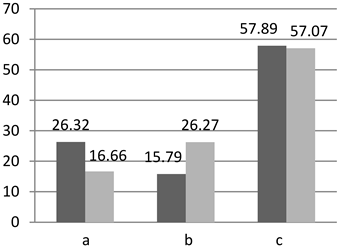 |
| (a) Positive; (b) Negative; (c) Indifferent | (a) Yes, positive; (b) Yes, negative; (c) No |
| QUESTION 12 Façade PV elements seen from the interior of the building, in your opinion… | |
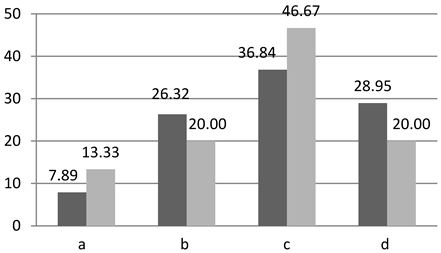 | |
| (a) Look better than from the outside; (b) Look worse; (c) Look the same; (d) I have no opinion | |
| QUESTION 13 Do you think that PV shelves should be adjustable? | QUESTION 14 Would you like to have the possibility of individual adjustment of PV shelves? |
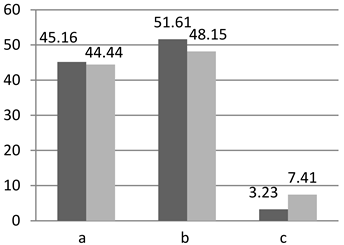 | 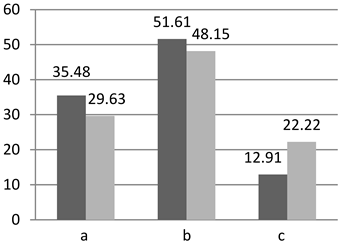 |
| (a) Yes; (b) It makes no difference; (c) No | (a) Yes; (b) It makes no difference; (c) No |
| QUESTION 1 Do you consider the external wall covered with PV modules to be a representative building façade? | QUESTION 2 Do you think that PV elements within the façade have an impact on the overall appearance of the building? | QUESTION 3 Do you think that PV elements affect the aesthetics of the façade when viewed from the outside? | |
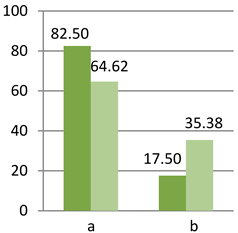 | 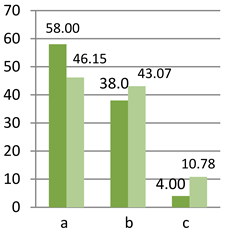 |  | |
| (a) Yes; (b) No | (a) Yes, big; (b) Yes, minor impact;(c) No | (a) Yes, positive; (b) Yes, negative;(c) No | |
| QUESTION 4 Do you consider the PV façade to have a modern image? | QUESTION 5 Do you consider the PV façade to be more interesting than the remaining façades of the building? | QUESTION 6 Does the PV façade evoke associations with an ecological building in your opinion? | |
 | 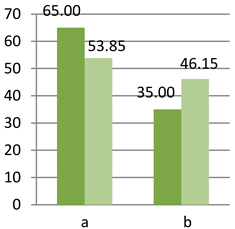 | 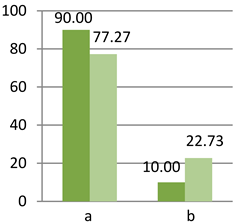 | |
| (a) Yes; (b) No | (a) Yes; (b) No | (a) Yes; (b) No | |
| QUESTION 7 Do you think that using PV elements within the façade can positively impact the image of the company that occupies this building? | QUESTION 8 When inside the building, do you feel the impact of façade PV elements on aesthetics of the internal space? | ||
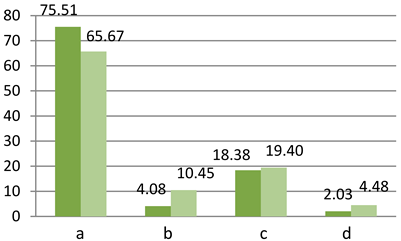 | 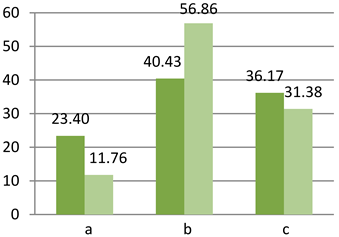 | ||
| (a) Yes; (b) No; (c) It makes no difference; (d) I don’t know | (a) Yes, strong; (b) No, but PV is perceptible; (c) No | ||
| QUESTION 9 When inside the building, do you feel the impact of façade PV elements on natural lighting? | QUESTION 10 When inside the building, your feelings related to the influence of PV elements on daylighting are: | ||
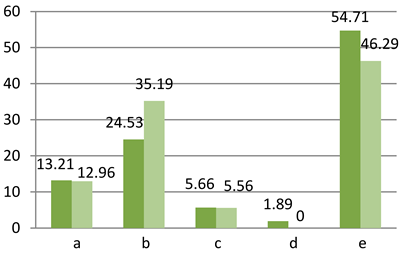 | 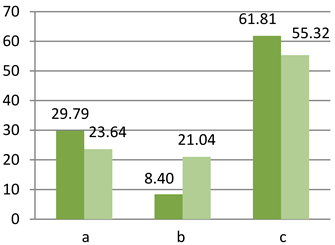 | ||
| (a) Yes, cast shadow; (b) Yes, limit daylight;(c) Yes, change daylight tint; (d) Other; (e) No | (a) Positive; (b) Negative; (c) Indifferent | ||
| QUESTION 11 When inside the building, do you feel the impact of façade PV elements on the view to the outside? | QUESTION 12 Façade PV elements seen from the interior of the building, in your opinion… | ||
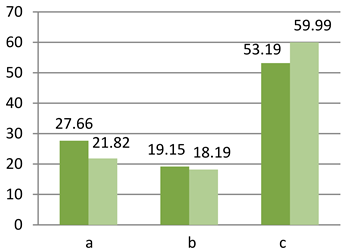 | 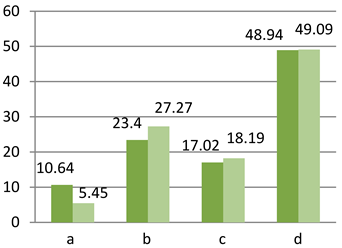 | ||
| (a) Yes, positive; (b) Yes, negative; (c) No | (a) Look better than from the outside; (b) Look worse; (c) Look the same; (d) I have no opinion | ||
| QUESTION 13 Do you think that PV shelves should be adjustable? | QUESTION 14 Would you like to have the possibility of individual adjustment of PV shelves? | ||
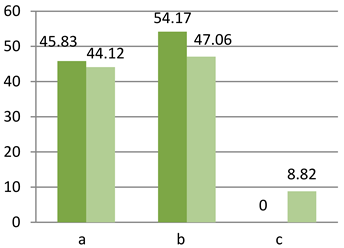 | 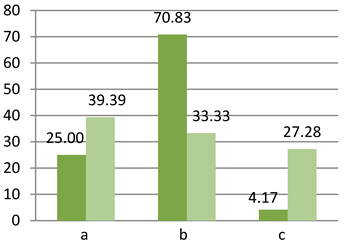 | ||
| (a) Yes; (b) It makes no difference; (c) No | (a) Yes; (b) It makes no difference; (c) No | ||
Disclaimer/Publisher’s Note: The statements, opinions and data contained in all publications are solely those of the individual author(s) and contributor(s) and not of MDPI and/or the editor(s). MDPI and/or the editor(s) disclaim responsibility for any injury to people or property resulting from any ideas, methods, instructions or products referred to in the content. |
© 2022 by the author. Licensee MDPI, Basel, Switzerland. This article is an open access article distributed under the terms and conditions of the Creative Commons Attribution (CC BY) license (https://creativecommons.org/licenses/by/4.0/).
Share and Cite
Marchwiński, J. Research on BIPV in Office and Public Utility Buildings in Aesthetic and Utility Context. Sustainability 2023, 15, 136. https://doi.org/10.3390/su15010136
Marchwiński J. Research on BIPV in Office and Public Utility Buildings in Aesthetic and Utility Context. Sustainability. 2023; 15(1):136. https://doi.org/10.3390/su15010136
Chicago/Turabian StyleMarchwiński, Janusz. 2023. "Research on BIPV in Office and Public Utility Buildings in Aesthetic and Utility Context" Sustainability 15, no. 1: 136. https://doi.org/10.3390/su15010136
APA StyleMarchwiński, J. (2023). Research on BIPV in Office and Public Utility Buildings in Aesthetic and Utility Context. Sustainability, 15(1), 136. https://doi.org/10.3390/su15010136






